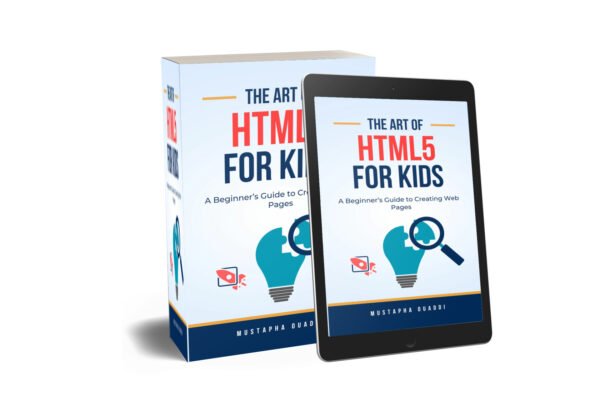CSS For Kids (2nd Edition)
🎨 Dive into the colorful world of web design with “CSS For Kids”! This engaging ebook is your child’s ticket to mastering Cascading Style Sheets (CSS) and adding some serious style to their web creations! 🌟 From vibrant colors to funky fonts and cool animations, kids will learn it all through fun activities and colorful…
HTML and CSS are the foundational technologies for building and designing web pages. Understanding these two languages is essential for anyone interested in web development. This article will provide an introduction to HTML (HyperText Markup Language) and CSS (Cascading Style Sheets), covering their basic concepts, structure, and how they work together to create web content.
What is HTML?
HTML stands for HyperText Markup Language. It is the standard language used to create web pages. HTML describes the structure of a webpage by using a series of elements and tags. These elements tell the browser how to display content on the screen.
Basic Structure of an HTML Document
An HTML document has a specific structure that consists of nested elements. Here’s a simple example:
<!DOCTYPE html>
<html>
<head>
<title>My First Web Page</title>
</head>
<body>
<h1>Hello, World!</h1>
<p>This is a paragraph of text.</p>
</body>
</html>
<!DOCTYPE html>: Declares the document type and version of HTML.<html>: The root element that contains all other elements.<head>: Contains meta-information about the document, such as the title.<title>: Sets the title of the webpage, which appears in the browser tab.<body>: Contains the content of the webpage, such as headings, paragraphs, images, and links.<h1>: A heading element, with levels ranging from<h1>(highest) to<h6>(lowest).<p>: A paragraph element that holds blocks of text.
Common HTML Elements
- Headings (
<h1>to<h6>): Define headings on the page. - Paragraphs (
<p>): Define blocks of text. - Links (
<a>): Create hyperlinks to other pages or resources. - Images (
<img>): Embed images in the page. - Lists (
<ul>,<ol>,<li>): Create unordered (bulleted) and ordered (numbered) lists. - Divs (
<div>): Define sections or divisions of content, used for styling and layout purposes. - Spans (
<span>): Inline container for text, used for styling purposes.
What is CSS?
CSS stands for Cascading Style Sheets. It is the language used to describe the presentation and design of an HTML document. CSS controls the layout, colors, fonts, and overall visual appearance of a webpage.
Basic Syntax of CSS
CSS is composed of selectors and declarations. A selector targets an HTML element, and a declaration defines the style to be applied. Here’s an example:
h1 {
color: blue;
font-size: 24px;
}
h1: The selector that targets all<h1>elements.color: The property that specifies the text color.blue: The value of thecolorproperty.font-size: The property that specifies the size of the text.24px: The value of thefont-sizeproperty.
Applying CSS to HTML
There are three main ways to apply CSS to an HTML document:
- Inline CSS: Directly within the HTML element using the
styleattribute.
<h1 style="color: blue;">Hello, World!</h1>
2. Internal CSS: Within a <style> tag inside the <head> section of the HTML document.
<style>
h1 {
color: blue;
}
</style>
3. External CSS: In a separate .css file linked to the HTML document using the <link> tag.
<!-- index.html -->
<head>
<link rel="stylesheet" href="styles.css">
</head>
/* styles.css */
h1 {
color: blue;
}
HTML For Kids (2nd Edition)
“HTML for Kids: A Beginner’s Guide to Creating Web Pages” is a comprehensive and engaging introduction to HTML designed specifically for young learners. This book takes a fun and interactive approach to teach kids the basics of HTML, the language used to create web pages.
Common CSS Properties
- Color: Sets the text color.
- Background: Sets the background color or image.
- Font-family: Specifies the font to be used.
- Font-size: Sets the size of the text.
- Margin: Sets the space outside an element.
- Padding: Sets the space inside an element.
- Border: Defines the border around an element.
- Width and Height: Set the dimensions of an element.
How HTML and CSS Work Together
HTML provides the structure of the webpage, while CSS is responsible for its presentation. By separating structure and presentation, developers can maintain and update their websites more efficiently. This separation also enhances accessibility, as the content (HTML) remains consistent even if the styles (CSS) are disabled or altered.
For example, the following HTML and CSS code creates a simple styled webpage:
HTML
<!-- index.html -->
<!DOCTYPE html>
<html>
<head>
<link rel="stylesheet" href="styles.css">
<title>Styled Web Page</title>
</head>
<body>
<h1>Welcome to My Website</h1>
<p>This is a paragraph of text styled with CSS.</p>
</body>
</html>
CSS
/* styles.css */
body {
font-family: Arial, sans-serif;
background-color: #f0f0f0;
color: #333;
}
h1 {
color: #0066cc;
}
p {
font-size: 16px;
line-height: 1.5;
}
Conclusion
HTML and CSS are essential tools for web development, providing the structure and style needed to create functional and visually appealing web pages. Mastering these languages is the first step toward becoming a proficient web developer. By understanding the basics of HTML and CSS, you can begin to build and design your own web content, laying the foundation for more advanced web development skills.
#HTML #CSS #WebDevelopment #LearnHTML #LearnCSS #FrontendDevelopment #WebDesign #Coding #Programming #WebDevBasics #HTMLCSS #WebDesignTips #WebDev #CodeNewbie #TechEducation #WebDesignBasics #WebDevelopmentTutorial #LearnToCode #WebTech #WebDevJourney







